Ancient Egyptian Weapons
Prior to the time of the ancient Egyptian civilization, technology was very rudimentary so weapons were very basic. Whether for personal protection, obtaining food, or for combat, weapons had a relatively short range. Throwing objects, such as boomerangs, stones, hefty sticks, and so forth, were common, as were stone maces, wooden clubs, and slingshots.
The History of Ancient Egyptian Weapons
When the ancient Egyptian civilization began to coalesce, weaponry became more sophisticated and began to include horn bows and stone-tipped arrows. Obsidian was used for arrow tips because of its glass-like properties that allow it to achieve a finely honed and razor-sharp edge.

© Ashley van Haeften - Knife with a gold handle
Gradually, the composite bow took precedence over the horn bow and weaponry became standardized. The pharaohs began to accumulate weaponry stockpiles in order to conquer other lands and to protect themselves from being conquered.
Ancient Egyptian Military Weapons
Offensive Weapons
The ancient Egyptians used their chariots as one of their more formidable offensive weapons. Built light, these chariots held two men – the driver and an archer. As the chariot sped toward an enemy, the archer would aim and shoot. A good archer can nock and shoot an arrow in less than two seconds. This tactic enabled a continual supply of arrows to rain down on an enemy.
The charioteer had a supply of spears that could be thrown at any enemy who tried to approach the chariot. Spearheads had razor-edged obsidian points and were used by infantry soldiers as well as charioteers. Foot archers supplemented the chariot archer in raining arrows down on the enemies and were considered to be the best archers in the Egyptian army. Since warriors wore little protection because of the desert climate, arrows and spears were excellent and deadly offensive weapons.
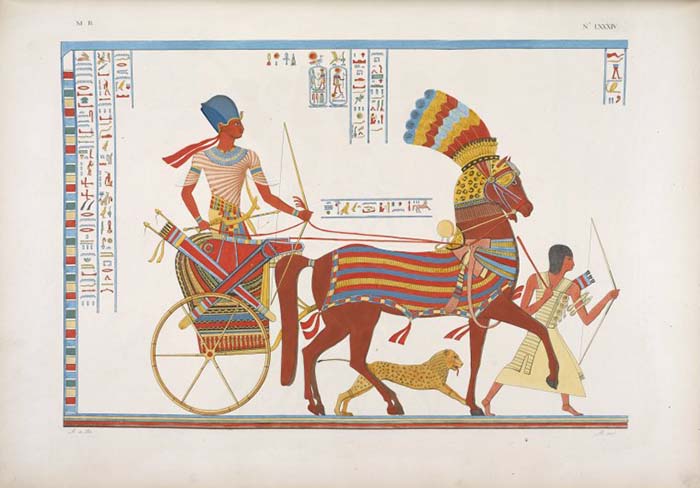
Depiction of an ancient Egyptian chariot
Formidable and deadly axes of various designs were also used to annihilate enemies of the ancient Egyptians. Many had broad, semi-circular stone blades that were attached to a wooden pole and could be swung in a deadly circle in hand-to-hand combat or thrown at an approaching adversary. Stone knives and daggers added to the Egyptian complement of relatively close-range weaponry.
The khopesh is a type of sword developed by the Egyptians for hand-to-hand combat. With its crescent-shaped blade and hooked end, this lethal weapon was able to grab an enemy or his shield with one end and cut and slash with the other. A hybrid version had a pointed end that would enable stabbing when the cutting and slashing proved inadequate to the task.
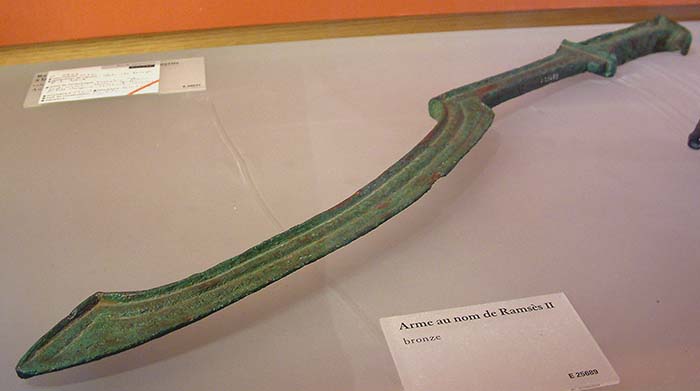
© Guillaume Blanchard - An Ancient Egyptian Khopesh
Early versions of the Egyptian battle axe featured crescent-shaped bronze heads that were affixed to grooves in the axe handle. Although effective for penetrating hide-covered shields, they were unstable and were subsequently upgraded. The newer versions had a hole in the head for the axe handle to be affixed and proved to be significantly sturdier than their predecessors.
The ancient Egyptians often used maces against their foes. A precursor to the battle axe, a mace has a round or spherical metal head affixed to a long wooden handle. The head can be circular or spherical. A circular mace usually had a finely honed edge which was used to slash and hack. The spherical maces often had objects embedded into the head and these objects would rip and tear whatever substance to which it was applied. Like battle axes, maces are very ugly and unpleasant weapons that are most effective when wielded at close range by a very strong person.
Defensive Weapons
In addition to the above weapons, which could be used both offensively and defensively, ancient Egyptians used an assortment of personal protection devices as defensive weapons.
Primary among the choice of defensive weapons was the shield. Most commonly, shields were constructed with a wood frame and then covered with leather. The more affluent soldiers, who may have been mercenaries, could afford bronze or metal shields.
Although the shield provided more protection for the soldier, it severely inhibited movement. Modern tests show that the leather shield was more effective than the metal or bronze shield due to several factors:
- The wood and leather shield was significantly lighter in weight and enabled more mobility.
- The leather shield was more effective at repelling sharp points due to its flexibility. The metal shield broke and the bronze shield split in half.
- A metal or bronze shield required a shield bearer. A leather shield could be held with one hand whilst the soldier fought with the other.
- Leather shields were significantly less expensive and therefore more soldiers could carry them.
Body armor was seldom worn due to the climate. However, many soldiers wore leather bands around their torso in order to protect their heart and other vital organs. Among the ancient Egyptians, metal armor was worn only by the pharaohs and only from the waist up; his lower extremities were protected by the chariot.
Helmets were worn by the pharaohs, not by the common foot soldier. In Egypt, they were made of metal and highly decorative, signifying that the wearer was the leader of the land.
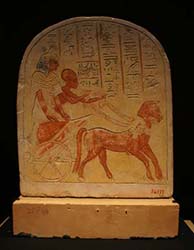
© Tjflex2 - Relief of a Chariot
Ancient Egyptian Hunting Weapons
Hunting weaponry was similar to military weaponry, with the exception of the chariots and the foot archers. Long-range weaponry was used to bring down the animal and lesser implements were used to finish the animal once it was brought down.
Land animals, such as deer or boar, could be killed from a distance with a spear or an arrow and the weapon could be retrieved with the animal. Flying food sources were brought down with an arrow, while fish were speared as they swam through the water.
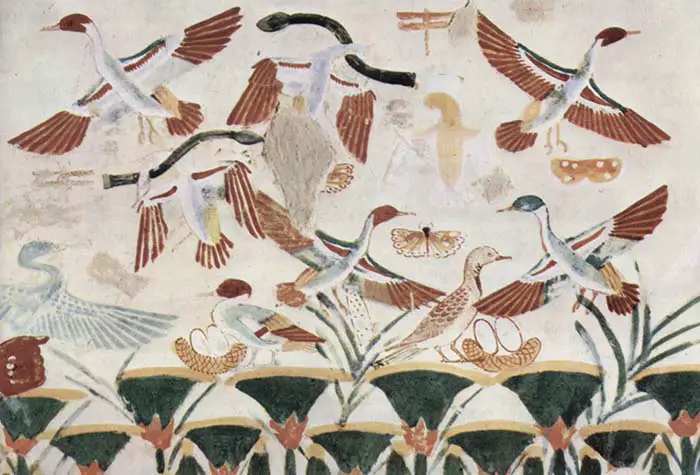
© The Yorck Project - Depiction of bird hunting with throw sticks
Since all weapons of this time were made by hand, they were usually retrieved with the prey that was killed or the fish that was speared. Ready-made weapons were unknown at this time so available weapons were used until they were no longer serviceable.
Ancient Egyptian Projectile Weapons
Weapons such as the catapult and the trebuchet were unknown in the early stages of the ancient Egyptian civilization. Egyptian projectile weapons were slingshots, javelins, spears, stones, boomerangs, and so forth.

© Iry-Hor - Ancient Egyptian spearhead
Boomerangs were very rudimentary, quite unlike the sophisticated boomerangs of today. In ancient Egypt, boomerangs were little more than shaped, heavy sticks, primarily used for hunting, and boomerangs were considered expendable. Often called throw sticks, decorative boomerangs were found in the tomb of King Tutankhamen.
Javelins were used more frequently than spears because they were lighter in weight and easier to make. Thus, if a javelin was broken or lost, it was easier to replace than a spear. Spears had a heavier shaft and were more difficult and costly to make.
Slingshots were very common projectile weapons; they were easy to make, very portable, and required very little training. Projectiles for slingshots were readily available and, when delivered by a man proficient with the weapon, could be as deadly as an arrow or a spear.
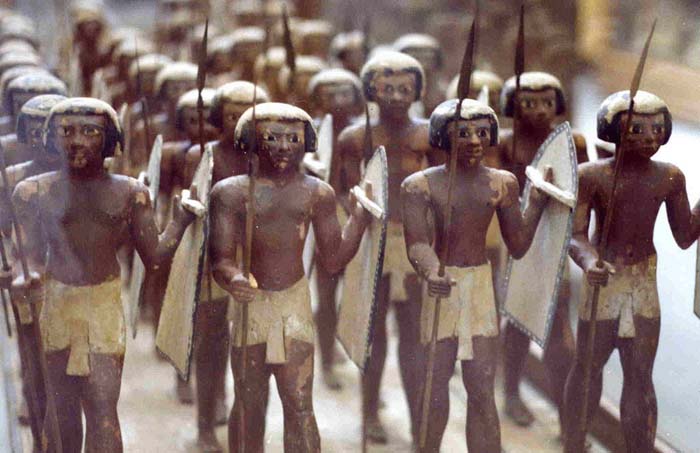
© Udimu - Soldier Figurines from the 11th Dynasty
Facts About Ancient Egyptian Weapons
- The ancient Egyptians greatly increased their knowledge of weapons by adapting the weapons used by their enemies. When the Egyptians captured a nation, they would incorporate any new weapons into their existing arsenal.
- Bows in ancient Egypt were originally made from the horns of an animal, such as a deer, that were joined together in the middle with wood and leather. Arrowheads were made of flint or bronze and attached to reeds.
- Until approximately 2050 BC, the ancient Egyptians used primarily wood and stone for their weapons. Around 2050 BC, bronze was added to their weaponry and yielded weapons that were sharper and lighter in weight. The Egyptians began to use iron in their weapons around 1550 BC.
- Egyptians preferred to attack their enemies directly rather than through the use of surprise attacks. The pharaohs felt that intimidating their enemies made them more likely to surrender.
- Although the ancient Egyptians conquered neighboring countries and assimilated their people, wealth, and technology, the Egyptians were not primarily a warring civilization. Ancient Egyptians are noted for their cultural advances, their structures, such as the Great Pyramids, their baths, and so forth. They had an extensive agricultural system and much of their wealth came from these sources rather than from their war efforts.
